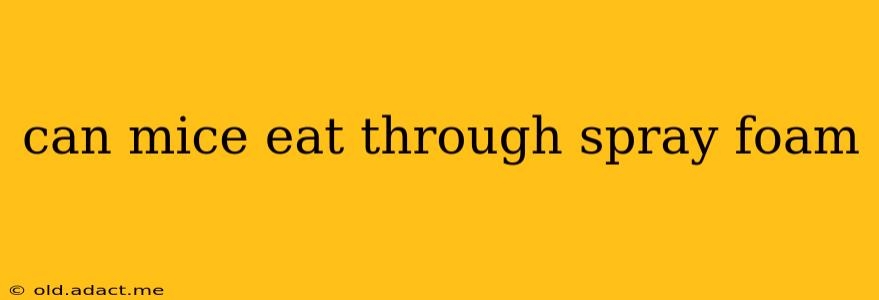Mice are notorious for their ability to squeeze into incredibly small spaces, making them persistent household pests. This raises a crucial question for homeowners concerned about insulation and pest control: can mice eat through spray foam insulation? The short answer is complex, but generally, no, mice cannot eat through spray foam insulation. However, they can still cause significant damage. Let's delve deeper into this issue.
What is Spray Foam Insulation?
Spray foam insulation is a popular choice for homeowners due to its excellent insulating properties and air sealing capabilities. It's a two-part polyurethane mixture that expands upon application, filling gaps and cracks effectively. This expansion creates a dense, rigid foam that adheres tightly to various surfaces.
Can Mice Chew Through Spray Foam?
While mice can't digest spray foam, they are persistent chewers. They need to gnaw constantly to keep their teeth from overgrowing. This means they will attempt to chew through almost any material that stands between them and a desirable nesting site or food source. Therefore, while they won't eat the spray foam, they can chew through it, especially if it's relatively thin or compromised in some way.
How Much Damage Can Mice Do to Spray Foam?
The extent of the damage depends on several factors:
- Thickness of the spray foam: Thicker layers of spray foam are naturally more resistant to chewing than thinner layers.
- Type of spray foam: Open-cell spray foam is softer and potentially easier to gnaw through than closed-cell spray foam, which is denser.
- The mouse's motivation: If a mouse is determined to reach a food source or create a nest, it will exert considerable effort to chew through obstacles.
- Access points: Mice often exploit existing gaps and cracks before attempting to chew through the foam.
What to Do if You Suspect Mice Have Damaged Your Spray Foam?
If you suspect mice have damaged your spray foam insulation, it's crucial to act promptly. Ignoring the problem can lead to:
- Compromised insulation: Damaged spray foam reduces its effectiveness, leading to higher energy bills and potential drafts.
- Further infestation: Holes in the spray foam provide entry points for more mice and other pests.
- Structural damage: Extensive chewing can compromise the structural integrity of your walls or other areas where the foam is applied.
First, identify and address the mouse infestation using appropriate methods such as traps, poison (used cautiously and responsibly), and exclusion techniques (sealing up all entry points). Then, inspect the affected areas to assess the extent of the damage. Repairing damaged spray foam usually requires professional help, as it necessitates careful removal of the compromised section and reapplication of fresh foam.
Will Mice Prefer Other Materials Over Spray Foam?
Yes, mice will generally prefer materials that are easier to chew through, such as wood, drywall, or even certain types of plastics. Spray foam, while chewable, presents a more significant challenge. They'll likely target easier entry points first.
How to Prevent Mice from Damaging Spray Foam?
Prevention is key:
- Seal all potential entry points: Before installing spray foam, ensure all cracks and gaps are sealed to prevent mice from accessing the area.
- Use a sufficient thickness of spray foam: A thicker layer provides better protection against chewing.
- Combine spray foam with other pest control measures: Using spray foam in conjunction with a comprehensive pest control strategy provides a more effective solution.
- Regular inspections: Periodically inspect your home for signs of rodent activity, including droppings and gnaw marks.
Is there any spray foam specifically designed to deter mice?
Currently, there isn't a spray foam specifically marketed as "mouse-proof." The effectiveness of the foam depends primarily on its thickness and the overall strategy to prevent rodent access.
In conclusion, while mice cannot digest spray foam insulation, their persistent chewing can damage it, compromising its effectiveness and creating further problems. A proactive approach combining effective pest control and proper installation of spray foam is crucial to prevent these issues. Remember to consult with pest control professionals for serious infestations or extensive damage.
